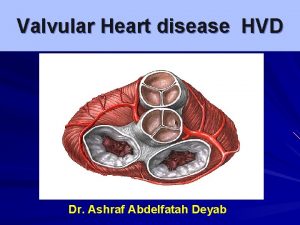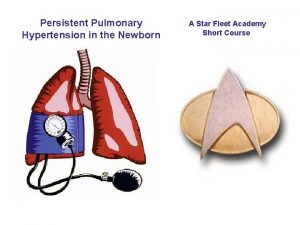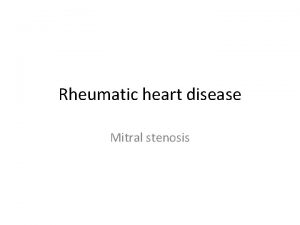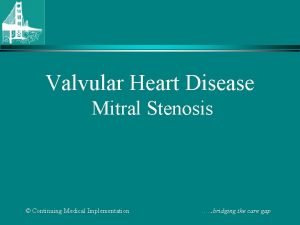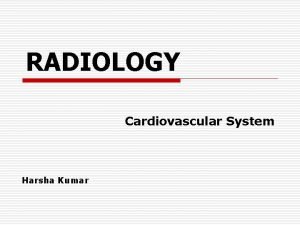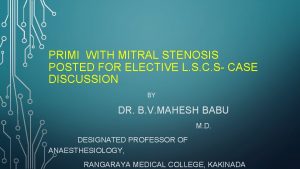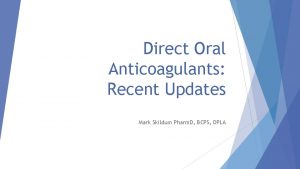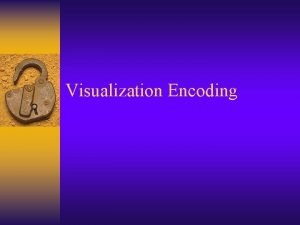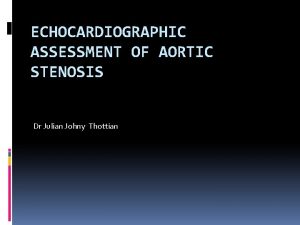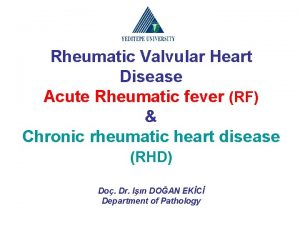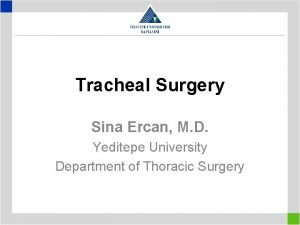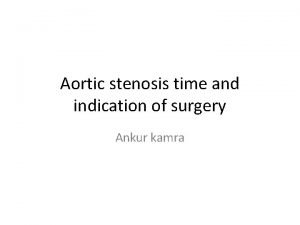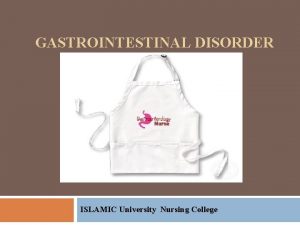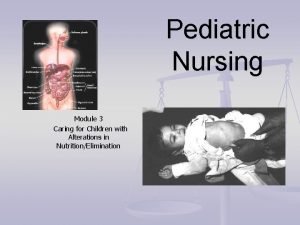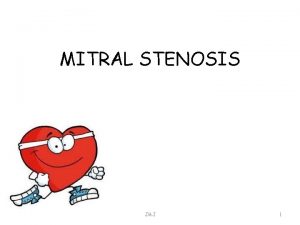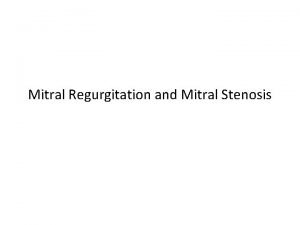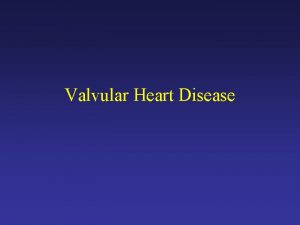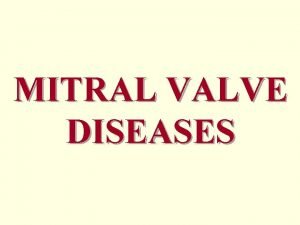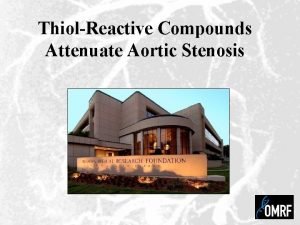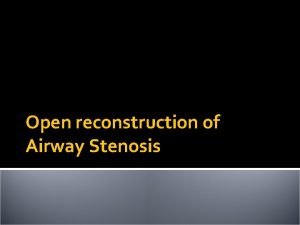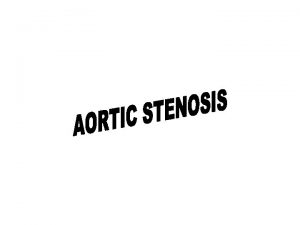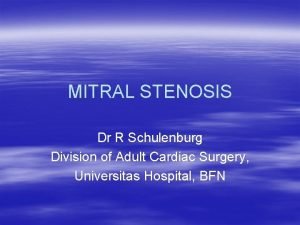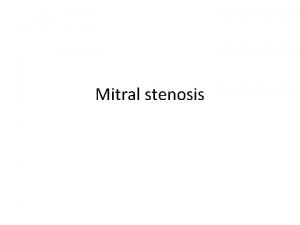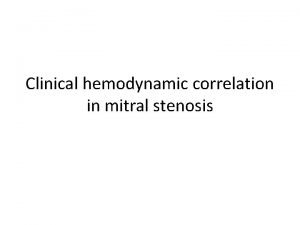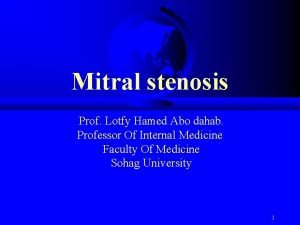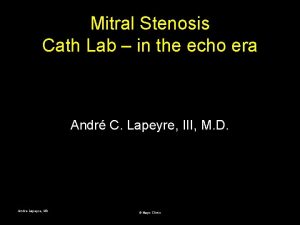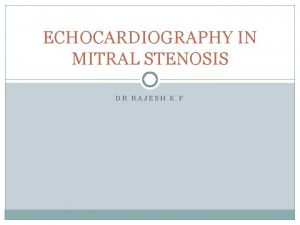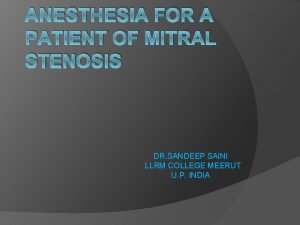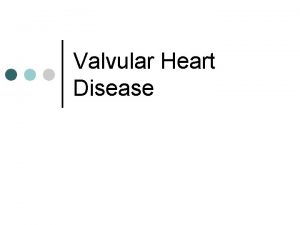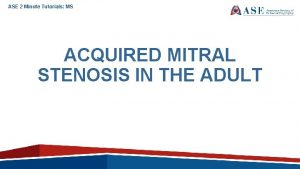OUTCOMES OF DOAC IN PATIENTS WITH MITRAL STENOSIS






















- Slides: 22

OUTCOMES OF DOAC IN PATIENTS WITH MITRAL STENOSIS JACC VOL 73, NO 10, 2019

INTRODUCTION • AF is associated with an increased risk of thromboembolic events. • DOACs are effective in preventing thromboembolisms among patients with AF. • However, patients with moderate to severe mitral stenosis and mechanical prosthetic heart valves have been excluded from all pivotal trials. • Warfarin remains the only oral anticoagulant approved for patients with AF and mechanical prosthetic heart valves or moderate to severe mitral stenosis.

INTRODUCTION • Mitral stenosis combined with AF increases the risk of a stroke >20 times. • Mechanism is related to blood stasis in the left atrium. • Strokes or systemic embolization can be the first manifestation of mitral stenosis. • Can occur in patients with mild MS even before the development of other systems. • Thrombi in MS, even in the absence of AF, are often large, and can cause disastrous embolisms.

INTRODUCTION • Efficacy of warfarin in the prevention of thromboembolisms in mitral stenosis can be hampered by the poor quality of the anticoagulation therapy. • More pronounced in developing countries. • Desirable to determine the efficacy of DOACs in patients with MS + AF. • Many physicians are unclear of the definition of “nonvalvular AF”, and some of them try off-label use of DOACs in patients with MS, especially in the case of adverse events with warfarin. • Medical records of these patients were reviewed and compared with patients who received conventional warfarin treatment.

VALVULAR AF • ACC 2019: • • “…refers to AF in the setting of moderate-to-severe mitral stenosis (potentially requiring surgical intervention) or in the presence of an artificial (mechanical) heart valve. ” ESC 2016 & EHRA 2018 • “…refers to AF patients that have either rheumatic valvular disease (predominantly mitral stenosis) or mechanical heart valves. ” • EHRA Type 1: • • “refers to AF patients with VHD needing therapy with a vitamin K antag- onist (VKA), including in particular moderate –severe mitral stenosis of rheumatic origin and mechanical prosthetic valve replacement. ” EHRA Type 2: • “refers to VHD patients need- ing thromboembolic prevention therapy for AF with a VKA or a NOAC, including essentially all other native valvular stenoses and insuffi- ciencies as well as mitral valve repair, bioprosthetic valve replacements and transaortic valve intervention (TAVI). ”

METHODS • 98% of the population of South Korea belong to the mandatory National Health Insurance Service (NHIS). • Remaining 2% receive medical benefits for the lowest income population. • This study used the HIRA database. • National organization that reviews and assesses medical costs and health care service quality. • Mandatory for all health care providers to join the program. • Cohort dataset includes: • Patient ID, age, sex, prescription drugs, and diagnoses.

STUDY POPULATION • Inclusion criteria: • • MS of any degree (rheumatic, nonrheumatic, with or without insufficiency) AF • • • If recorded at least once in the database on hospital discharge or more than twice in the outpatient department. On oral anticoagulation for at least 3 weeks Between February 2008 and January 2017. • Exclusion criteria: • All patients who had a history of mitral valve surgery.

DATA COLLECTION AND STUDY OUTCOMES • • • Basic demographic data of each subject was acquired from the database. CHA 2 DS 2 -VASc score was calculated. Primary Outcome: • first hospitalisation with a principal diagnosis of an ischaemic stroke or systemic embolism after 3 weeks of DOAC use. • • Ischaemic strokes and systemic embolisms were defined as patients who did not have the preceding codes recorded for >1 year and new recorded codes were displayed consecutively at least twice at the time of the hospital discharge diagnosis. Safety Outcome: • Occurrence of an intracranial haemorrhage.

PATIENT CHARACTERISTICS

PATIENT CHARACTERISTICS DOAC N (%) Dabigatran 367 (32. 9%) Rivaroxaban 472 (42. 3%) Apixaban 192 (17. 2%) Edoxaban 84 (7. 5%)

OUTCOMES • Mean follow-up duration was 27 months.


DISCUSSION • First study to investigate the efficacy of DOACs in patients with MS and AF. • Main findings: • • DOACs were associated with lower rates of thromboembolism. DOACs were as effective as warfarin in preventing haemorrhagic strokes.

DISCUSSION • In each of the 4 DOAC trials (edoxaban: ENGAGE AF-TIMI 48; dabigatran: RE-LY; rivaroxaban: ROCKET-AF; apixaban: ARISTOTLE): • • Patients with mechanical heart valves or haemodynamically significant mitral stenosis were excluded. All included mild MS (ENGAGE AF-TIMI 48: 254, RE-LY: 193, ARISTOTLE: 131, ROCKET-AF: not reported). • No published data on the effects of DOACs in patients with moderate to severe MS thus far. • However, this study was not able to ascertain the severity of MS.

DISCUSSION • RE-ALIGN trial • Randomized, Phase II Study to Evaluate the Safety and Pharmacokinetics of Oral Dabigatran Etexilate in Patients after Heart Valve Replacement) • Dabigatran increased both embolic and bleeding events.

DISCUSSION • Oral anticoagulation with a vitamin K antagonist is recommended in patients with: • • MS + AF MS + SR + history of prior embolic event or left atrial thrombus. • MS has much higher risk than other native valve diseases for strokes and should receive strict anticoagulation therapy. • However, the REMEDY trial showed that only a quarter of patients had an INR that was in a therapeutic range (on enrollment).

WARFARIN TREATMENT IN KOREAN PATIENTS • Real-world data shows that the quality of warfarin therapy is inadequate in Koreans. • A multicenter observational study of the quality of anticoagulation with warfarin in Korean patients showed that only 31% of patients were within therapeutic range – 41% INR <2. • Physicians concerns regarding high incidence of ICH with anticoagulation in the Asian population may have caused them to make the INR target low or not prescribe an anticoagulant. • HR 4. 06 vs Caucasians.

WARFARIN TREATMENT IN KOREAN PATIENTS • Unlike the CHA 2 DS 2 -VASc score system, doctors may not be familiar with the stroke risk of MS + AF. • A nationwide (Korea) study on the trends of antithrombotic therapy in high-risk AF patients showed that <41% received anticoagulants prior to DOACs being approved.

DISCUSSION • Rate of thromboembolic events with DOAC therapy in MS + AF was significantly lower than that in the warfarin group. • May be due to the low therapeutic control of the INR in the warfarin group. • Events rates were higher in this study population: 2. 22% in the DOAC group, and 4. 19% in the warfarin group. • In comparison, the DOAC trials had event rates <2%.

LIMITATIONS • Study conducted with data from off-label use. • Several reasons why patients received DOACs • • Developing thromboembolisms or bleeding events during warfarin use. Off label-use of DOACs before the evaluation of MS. Mild MS. Retrospective observational study using the HIRA database. • • • Unable to ascertain the severity of MS and other valvular pathologies. Data does not contain lab findings or clinical measurements. Unable to rule out misclassification of patients with MS. • Diagnoses made based on ICD-10 codes alone.

LIMITATIONS • Excluded patients who underwent mitral valve surgery in this study protocol. • Exclusion of patients who had severe mitral MS and were at a higher risk for thromboembolic events. • Reduced study population after propensity score matching. • Information regarding the INR and time in therapeutic range was not available.

CONCLUSION • This study revealed worthwhile exploratory data on the effectiveness of DOACs in patients with mitral stenosis and AF. • DOAC use appears reasonable in patients with MS and AF. • Clinical trial evaluation of the superiority of DOACs in moderate to severe MS would be justified.
 Define mitral stenosis
Define mitral stenosis Mitral stenosis pulmonary hypertension
Mitral stenosis pulmonary hypertension Rvh cxr
Rvh cxr Pinched and blue facies
Pinched and blue facies Define mitral stenosis
Define mitral stenosis Mitral stenosis chest x ray
Mitral stenosis chest x ray Site:slidetodoc.com
Site:slidetodoc.com Wilkins score ms
Wilkins score ms Perhatikan gambar disamping
Perhatikan gambar disamping Apixaban dosing
Apixaban dosing Discogenic low back pain
Discogenic low back pain Encoding
Encoding Cervical ectropion
Cervical ectropion Continuity equation echo
Continuity equation echo Pyloric stenosis
Pyloric stenosis Hypertrophic pyloric stenosis
Hypertrophic pyloric stenosis Fish mouth buttonhole stenosis
Fish mouth buttonhole stenosis Cricoid cartillage
Cricoid cartillage Stages of aortic stenosis
Stages of aortic stenosis Murmur in asd
Murmur in asd Fecalith
Fecalith Chipaultovo pravidlo
Chipaultovo pravidlo Pyloromyotomy surgery
Pyloromyotomy surgery
